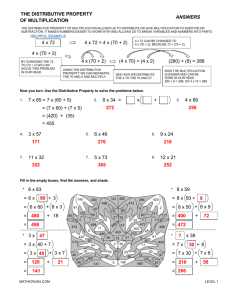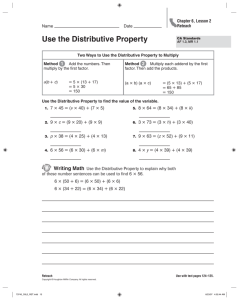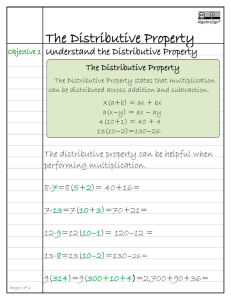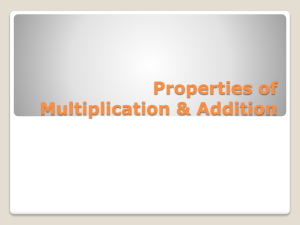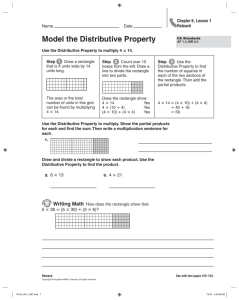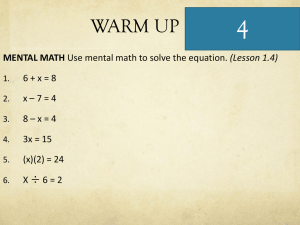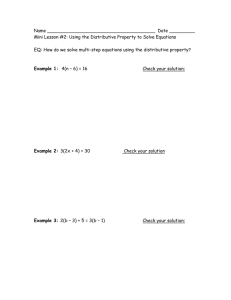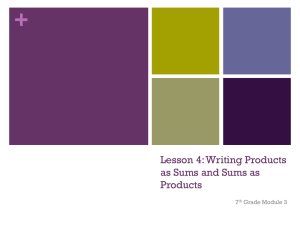The Distributive Property
advertisement
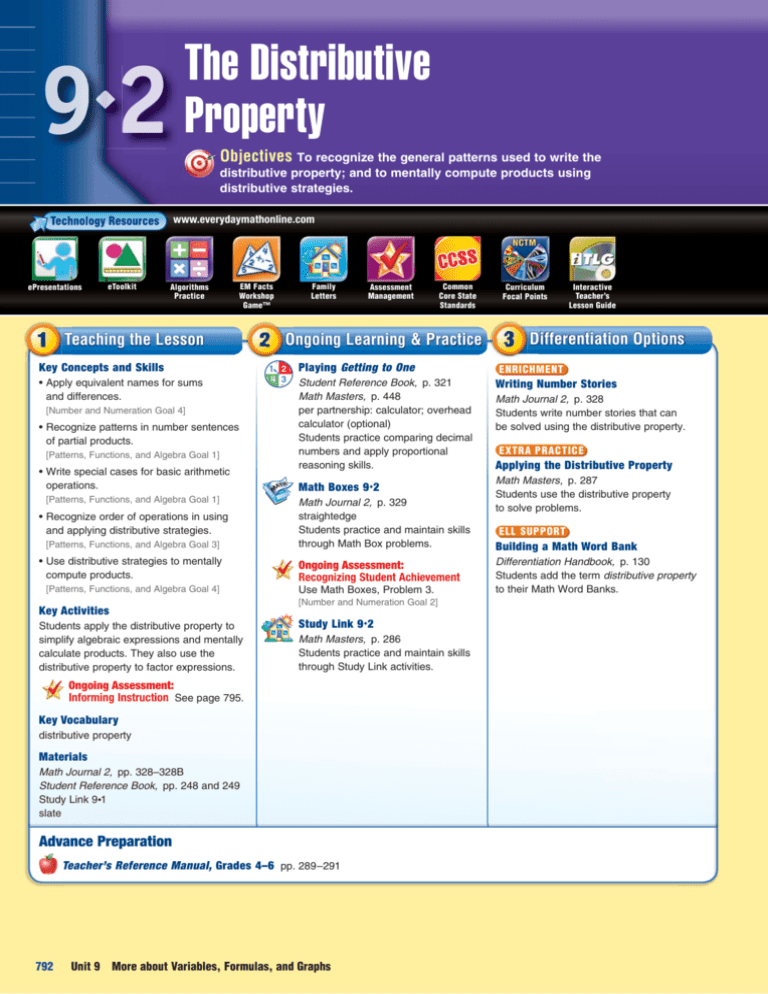
The Distributive Property Objectives To recognize the general patterns used to write the distributive property; and to mentally compute products using d distributive strategies. www.everydaymathonline.com ePresentations eToolkit Algorithms Practice EM Facts Workshop Game™ Teaching the Lesson Key Concepts and Skills • Apply equivalent names for sums and differences. [Number and Numeration Goal 4] • Recognize patterns in number sentences of partial products. [Patterns, Functions, and Algebra Goal 1] • Write special cases for basic arithmetic operations. [Patterns, Functions, and Algebra Goal 1] • Recognize order of operations in using and applying distributive strategies. [Patterns, Functions, and Algebra Goal 3] • Use distributive strategies to mentally compute products. [Patterns, Functions, and Algebra Goal 4] Family Letters Students apply the distributive property to simplify algebraic expressions and mentally calculate products. They also use the distributive property to factor expressions. Ongoing Learning & Practice 1 2 4 3 Playing Getting to One Student Reference Book, p. 321 Math Masters, p. 448 per partnership: calculator; overhead calculator (optional) Students practice comparing decimal numbers and apply proportional reasoning skills. Math Boxes 9 2 Math Journal 2, p. 329 straightedge Students practice and maintain skills through Math Box problems. Ongoing Assessment: Recognizing Student Achievement Use Math Boxes, Problem 3. Study Link 9 2 Math Masters, p. 286 Students practice and maintain skills through Study Link activities. Ongoing Assessment: Informing Instruction See page 795. Key Vocabulary distributive property Materials Math Journal 2, pp. 328–328B Student Reference Book, pp. 248 and 249 Study Link 91 slate Advance Preparation Teacher’s Reference Manual, Grades 4–6 pp. 289–291 Unit 9 Common Core State Standards [Number and Numeration Goal 2] Key Activities 792 Assessment Management More about Variables, Formulas, and Graphs Curriculum Focal Points Interactive Teacher’s Lesson Guide Differentiation Options ENRICHMENT Writing Number Stories Math Journal 2, p. 328 Students write number stories that can be solved using the distributive property. EXTRA PRACTICE Applying the Distributive Property Math Masters, p. 287 Students use the distributive property to solve problems. ELL SUPPORT Building a Math Word Bank Differentiation Handbook, p. 130 Students add the term distributive property to their Math Word Banks. Mathematical Practices SMP1, SMP2, SMP3, SMP5, SMP6, SMP7, SMP8 Getting Started Content Standards 6.NS.4, 6.EE.2, 6.EE.2b, 6.EE.3 Mental Math and Reflexes Math Message Be ready to explain how to mentally find the following products: Students find the total number of objects in a set when a fractional part of the set is given. Suggestions: 4 ∗ 36 = ? 1 _ of the people in the room is 6. 36 99 ∗ 8 = ? $11.50 ∗ 5 = ? 6 1 _ of the books on a shelf is 12. 108 9 Study Link 9 1 Follow-Up 5 Briefly review the answers. 2 _ of the marbles in a bag is 18. 45 7 _ of the crayons in a box is 56. 64 8 4 _ of the pages in a book is 40. 150 15 6 _ of the questions on a test is 108. 126 7 Discuss students’ strategies. Some students may prefer solving the problems by first translating them to equations. For example, 4 4 _ _ 15 of the pages in a book is 40 can be translated as 15 ∗ x = 40. 1 Teaching the Lesson ▶ Math Message Follow-Up WHOLE-CLASS DISCUSSION ELL Students share solution strategies. Help them record their strategies as number sentences. Be sure to include distributive strategies as you record solutions. Examples: 4 ∗ 36 = 4 ∗ (30 + 6) = (4 ∗ 30) + (4 ∗ 6) = 120 + 24 = 144, or 4 ∗ 36 = 4 ∗ (40 - 4) = (4 ∗ 40) - (4 ∗ 4) = 160 - 16 = 144 99 ∗ 8 = (100 - 1) ∗ 8 = (100 ∗ 8) - (1 ∗ 8) = 800 - 8 = 792, or 99 ∗ 8 = (90 + 9) ∗ 8 = (90 ∗ 8) + (9 ∗ 8) = 720 + 72 = 792 $11.50 ∗ 5 = ($12.00 - $0.50) ∗ 5 = ($12.00 ∗ 5) - ($0.50 ∗ 5) = $60.00 - $2.50 = $57.50, or $11.50 ∗ 5 = ($11.00 + $0.50) ∗ 5 = ($11.00 ∗ 5) + ($0.50 ∗ 5) = $55.00 + $2.50 = $57.50 Lesson 9 2 793 Student Page Algebra Adjusting the Activity The Distributive Property You have been using the distributive property for years, probably without knowing it. For example, when you solve 40 * 57 with partial products, you think of 57 as 50 7 and multiply each part by 40. The distributive property says: 40 * (50 7) (40 * 50) (40 * 7). The distributive property can be illustrated by finding the area of a rectangle. 57 * 40 40 * 50 2000 40 * 7 280 40 * 57 2280 Show how the distributive property works by finding the area of the rectangle in two different ways. To extend the activity and review order of operations, write the expressions without parentheses. A U D I T O R Y K I N E S T H E T I C T A C T I L E V I S U A L Ask students to look for patterns in the number sentences. Include the following points in your discussion: Method 1 Find the total width of the rectangle and multiply that by the height. A 3 cm * (4 cm 2 cm) 3 cm * 6 cm 18 cm2 One of the factors is rewritten as a sum (or difference) of two numbers, each of which can be easily multiplied by the other factor. Method 2 Find the area of each smaller rectangle, and then add these areas. A (3 cm * 4 cm) (3 cm * 2 cm) 12 cm2 6 cm2 18 cm2 Both methods show that the area of the rectangle is 18 cm2. 3 * (4 2) (3 * 4) (3 * 2). This is an example of the distributive property of multiplication over addition. The distributive property of multiplication over addition can be stated in two ways: a * (x y) (a * x) (a * y) Parentheses are useful for keeping track of this sum (or difference) when it is rewritten. The original product becomes the sum (or difference) of two simple products. (x y) * a (x * a) (y * a) This strategy for making mental calculations is based on the distributive property. This property gets its name because the factor outside the parentheses is distributed to each of the terms within the parentheses. To support English language learners, model the meaning of the word distribute. (See margin.) Student Reference Book, p. 248 ▶ Summarizing the The papers are distributed to each student. WHOLE-CLASS DISCUSSION Distributive Property (Student Reference Book, pp. 248 and 249) The factor is distributed to each term. Student Page Algebra The distributive property of multiplication over subtraction can also be stated in two ways: Algebraic Thinking Use the two examples on pages 248 and 249 of the Student Reference Book to discuss how the distributive property summarizes students’ work in Lesson 9-1. Then review the four different general patterns for the distributive property. Remind students that, as with other equations, they can interchange the left and right sides. Distributive Property of Multiplication over Addition a ∗ (x + y) = (a ∗ x) + (a ∗ y) a * (x y) (a * x) (a * y) (x y) * a (x * a) (y * a) (x + y) ∗ a = (x ∗ a) + (y ∗ a) Show how the distributive property of multiplication over subtraction works by finding the area of the shaded part of the rectangle in two different ways. Method 1 Multiply the width of the shaded rectangle Distributive Property of Multiplication over Subtraction by its height. a ∗ (x - y) = (a ∗ x) - (a ∗ y) A 3 cm * (6 cm 2 cm) 3 cm * 4 cm 12 cm2 (x - y) ∗ a = (x ∗ a) - (y ∗ a) Method 2 Subtract the area of the unshaded rectangle from the entire area of the whole rectangle. A (3 cm * 6 cm) (3 cm * 2 cm) 18 cm2 6 cm2 12 cm2 Both methods show that the area of the shaded part of the rectangle is 12 cm2. 3 * (6 2) (3 * 6) (3 * 2) This is an example of the distributive property of multiplication over subtraction. Use the distributive property to solve the problems. 1. 6 * (100 40) 2. (35 15) * 6 3. 4 * (80 7) 4. Use a calculator to verify that 1.23 * (456 789) (1.23 * 456) (1.23 * 789). Check your answers on page 423. Student Reference Book, p. 249 794 Unit 9 More about Variables, Formulas, and Graphs Student Page Make sure students understand that these general statements do not show four different properties but are different ways of stating the same general property. Demonstrate this by writing special cases. Date Time LESSON 9 2 248 249 The distributive property is a number property that combines multiplication with addition or multiplication with subtraction. The distributive property can be stated in 4 different ways. Multiplication over Addition Examples: a ∗ (x + y) = (a ∗ x) + (a ∗ y) 7 ∗ (30 + 5) = (7 ∗ 30) + (7 ∗ 5) = 245 The Distributive Property Multiplication over Subtraction For any numbers a, x, and y: For any numbers a, x, and y: a º (x y) (a º x ) (a º y) y) (x y ) º a (x º a) (y º a) a º (x y) (a º x) (a º y) (x y) º a (x º a) (y º a) Use the distributive property to fill in the blanks. 1. (x + y) ∗ a = (x ∗ a) + (y ∗ a) (30 + 5) ∗ 7 = (30 ∗ 7) + (5 ∗ 7) = 245 a ∗ (x - y) = (a ∗ x) - (a ∗ y) 7 ∗ (40 - 5) = (7 ∗ 40) - (7 ∗ 5) = 245 6 º 34 ( 3. (6 º 70) (6 º 4) 4. ( 5. 8 º (90 3) ( 6. (50 º 7) (8 º 7. 9 º (20 7) (9 º 9. 10. 11. 12. 13. 14. 15. 16. Ongoing Assessment: Informing Instruction 6 2. 8. (x - y) ∗ a = (x ∗ a) - (y ∗ a) (40 - 5) ∗ 7 = (40 ∗ 7) - (5 ∗ 7) = 245 4 º (70 8) (4 º 40 6 70 ) (4 º º 30) ( 6 6 8 º (70 4 ) º 8 (40 º 8) (6 º 8 7 ) º 4) ) 8 ) º 90) (8 º 3) ) ( 50 8 ) º 7 20 ) ( 9 º 7) 4 º (5 6) ( 4 º 5 ) ( 4 º 6 ) (41 19) º 7 ( 41 º 7 ) ( 19 º 7 ) r ) ( 4 º r) (18 4) º r (18 º 7 º (w 6 ) ( 7 º w) ( 7 º 6) n º (13 27) ( n º 13 ) ( n º 27 ) (f 8) º 15 ( f º 15 ) ( 8 º 15 ) (29 º x) (12 º x) ( 29 12 ) º x (6 º d) (6 º 7) 6 º (d 7) (5 º 12) (5 º h) 5 º (12 h) Math Journal 2, p. 328 Students may recognize that they can use the Commutative Property of Multiplication to write the second general pattern and special case in each example. Although they can also change the order of numbers or expressions being added, watch for students who try to change the order in which numbers or expressions are subtracted. Pose problems that students can solve mentally by applying the distributive property. Suggestions: 6 ∗ 57 342 99 ∗ 80 7,920 14 ∗ 10.5 147 1 ∗ 42 63 1_ 2 103 ∗ 31 3,193 998 ∗ 201 200,598 ▶ Using the Distributive Property PARTNER ACTIVITY (Math Journal 2, p. 328) Game Master Name Date Time Getting to One Record Sheets Algebraic Thinking The problems on journal page 328 provide practice with four different ways of stating the distributive property. For most of the problems, there are many ways to fill in the blanks to obtain true sentences. Each problem, however, has a unique solution in the form of the distributive property. For example, in Problem 1, 4 ∗ (70 + 8) = (4 ∗ 50) + (4 ∗ 28) is a true sentence, but 4 ∗ (70 + 8) = (4 ∗ 70) + (4 ∗ 8) is the only solution in the form of the distributive property. When students have finished, go over their answers. 1 2 4 3 321 Player’s Name ______________________ Player’s Name ______________________ Draw a line to separate each round. Guess Display on calculator (to nearest 0.01) Result Write: L if too large S if too small ✔ if exact Draw a line to separate each round. Guess Display on calculator (to nearest 0.01) Result Write: L if too large S if too small ✔ if exact Adjusting the Activity Divide journal page 328 into two sections—problems without variables (Problems 1–9) and problems with variables (Problems 10–16). Have students use a blank sheet of paper to cover the second section while they work on the first section. A U D I T O R Y K I N E S T H E T I C T A C T I L E V I S U A L Math Masters, p. 448 Lesson 9 2 795 ▶ Factoring with the WHOLE-CLASS ACTIVITY Distributive Property (Math Journal 2, pp. 328–328B) Have students look at Problem 5 on journal page 328. Remind them that this problem illustrates how the distributive property can be used to mentally solve the multiplication problem 8 ∗ 93. Tell students that when they apply the distributive property to solve multiplication problems mentally, they are distributing a number across a sum. In Problem 5, the 8 is distributed across the sum 90 + 3. This process is called expanding the expression 8 ∗ (90 + 3). Now have students look at Problem 6. Ask them how Problem 6 is different from Problem 5. Sample answer: The left side of the equation in Problem 6 shows the expression expanded. Tell students that in this problem, the 7 is “undistributed” from the expression (50 ∗ 7) + (8 ∗ 7). Applying the distributive property in this way is called factoring the expression (50 ∗ 7) + (8 ∗ 7). Because 7 is a factor of both 50 ∗ 7 and 8 ∗ 7, it is a factor of the whole expression. In all the examples of factored expressions students have seen so far, the two addends have been written as products. Tell students that they can use their knowledge of greatest common factors to factor an expression even if the two addends are written as whole numbers. Write 33 + 12 on the board. Walk students through the following steps to help them use the distributive property to factor this expression: Step 1: Find the greatest common factor of 33 and 12. List the factors of 33: 1, 3, 11, and 33. List the factors of 12: 1, 2, 3, 4, 6, and 12. From the lists, you can see that the greatest common factor of 33 and 12 is 3. Step 2: Write 33 and 12 as products, with their GCF as one of the factors. 33 = 3 ∗ 11 12 = 3 ∗ 4 Step 3: Rewrite the original sum, substituting the products from Step 2 for the addends. 33 + 12 = 3 ∗ 11 + 3 ∗ 4 Step 4: Use the distributive property to factor the expression on the right side of the equal sign, or “undistribute” the 3. 33 + 12 = 3 ∗ (11 + 4) 795A Unit 9 More about Variables, Formulas, and Graphs Student Page Point out that because you factored out the greatest common factor, the addends 11 and 4 have no common factor other than 1. Help students use mathematical language to express the meaning of the final number sentence. You might use language such as the following: ● 3 is a factor of the expression 33 + 12. ● The sum 33 + 12 is a multiple of the sum 11 + 4. ● Factoring 3 out of the expression 33 + 12 produces the expression 3 ∗ (11 + 4). Date Time LESSON 92 Factoring Sums The Distributive Property of Multiplication over Addition a ∗ (x + y ) = a ∗ x + a ∗ y (a ∗ x ) + (a ∗ y ) = a ∗ (x + y ) (x + y ) ∗ a = x ∗ a + y ∗ a (x ∗ a) + (y ∗ a) = (x + y ) ∗ a The equation 21 + 15 = 3 ∗ (7 + 5) is a special case of the distributive property in which the addends on the left side are written as whole numbers instead of products. This equation tells you a lot about these numbers. Here are some true statements about the relationships among the numbers and expressions in this equation: 3 is a factor of both 21 and 15. 3 is a factor of the expression 21 + 15. Write other sums on the board. Ask students to identify the greatest common factor of the addends and use the GCF to factor the expression. Encourage students to check that the final two addends have no common factor other than 1. Suggestions: 18 + 26 2; 2 ∗ (9 + 13) 24 + 36 12; 12 ∗ (2 + 3) The expression 21 + 15 is a multiple of the expression 7 + 5. When you use the distributive property to write 21 + 15 as 3 ∗ (7 + 5), we say you factor 3 out of the sum 21 + 15. You can use the distributive property to factor a sum of any two whole numbers. In this activity, you will factor out the greatest common factor of two addends. You will be rewriting the original sum as a multiple of another sum whose addends have no common factors other than 1. Complete the following steps for each sum. a. Find the greatest common factor of the two addends. b. Use the distributive property to factor the GCF out of the sum. Complete the number sentence to show the result. c. Fill in the blanks to give an example of what your number sentence shows. Example: 16 + 6 2 a. Greatest common factor: b. Number sentence: 16 + 6 = c. Fill in the blanks: The expression the expression 2 8 +3 8 + 3 ) ∗( 16 + 6 is a multiple of . 25 + 20 5; (5 + 4) ∗ 5 Math Journal 2, p. 328A 27 + 15 3; 3 ∗ (9 + 5) 328A_328B_EMCS_S_G6_MJ2_U09_576442.indd 328A 3/9/11 11:13 AM 21 + 35 7; 7 ∗ (3 + 5) 44 + 52 4; (11 + 13) ∗ 4 When students seem comfortable with the procedure, read journal page 328A as a class. Then have students work with a partner to complete the problems on journal page 328B. Student Page Date Time LESSON Factoring Sums 92 continued Follow the directions on journal page 328A. 1. 2. 3. 4. 5. 18 + 10 2 a. Greatest common factor: b. Number sentence: 18 + 10 = c. Fill in the blanks: 2 2 9 ∗( is a factor of the sum + 5 18 + ) 10 . 30 + 25 5 a. Greatest common factor: b. Number sentence: 30 + 25 = ( c. Fill in the blank: The expression 30 + 25 is a expression 6 + 5. 6 5 )∗ 5 multiple of the + 48 + 28 a. Greatest common factor: b. Number sentence: c. Fill in the blanks: and 28. 48 4 27 + 63 4 + 28 ∗( 12 + 7 ) 48 9 a. Greatest common factor: b. Number sentence: c. Fill in the blanks: When the number 27 + 63 4 = is the greatest common factor of the numbers Sample answer: 27 + 63 = 9 ∗ (3 + 7) 9 is factored out of the sum , the result is the expression 9 ∗ (3 + 7). 36 + 60 a. Greatest common factor: b. Number sentence: c. Write your own sentence. 12 Sample answer: 36 + 60 = 12 ∗ (3 + 5) Sample answer: The sum 36 + 60 is a multiple of the sum 3 + 5. Math Journal 2, p. 328B 328A_328B_EMCS_S_G6_MJ2_U09_576442.indd 328B 3/9/11 11:13 AM Lesson 9 2 795B Student Page Games Links to the Future Getting to One Materials 1 calculator Players 2 Skill Estimation Students will apply their knowledge of the distributive property when they factor and multiply polynomials in future algebra courses. Object of the game To correctly guess a mystery number in as few tries as possible. Directions 1. Player 1 chooses a mystery number that is between 1 and 100. For a decimal number, the places to the right of the decimal point with digits in them are called decimal places. For example, 4.06 has 2 decimal places, 123.4 has 1 decimal place, and 0.780 has 3 decimal places. 2. Player 2 guesses the mystery number. 3. Player 1 uses a calculator to divide Player 2’s guess by the mystery number. Player 1 then reads the answer in the calculator display. If the answer has more than 2 decimal places, only the first 2 decimal places are read. 4. Player 2 continues to guess until the calculator result is 1. Player 2 keeps track of the number of guesses. 5. When Player 2 has guessed the mystery number, players trade roles and follow Steps 1–4 again. The player who guesses their mystery number in the fewest number of guesses wins the round. The first player to win 3 rounds wins the game. ▶ Playing Getting to One Player 1 chooses the mystery number 65. Player 2 guesses: 45. Player 1 keys in: 45 Answer: 0.69 Too small. 65 . Player 2 guesses: 73. Player 1 keys in: 73 Answer: 1.12 Too big. 65 . Player 2 guesses: 65. Player A keys in: 65 Answer: 1. Just right! 65 . 2 Ongoing Learning & Practice PARTNER ACTIVITY (Student Reference Book, p. 321; Math Masters, p. 448) Divide the class into pairs. Distribute a calculator and a game record sheet (Math Masters, p. 448) to each partnership. Students read the directions on page 321 in their Student Reference Book. If an overhead calculator is available, ask a volunteer to demonstrate how to play the game. Encourage students to play a practice game. Advanced Version Allow mystery numbers up to 1,000. Student Reference Book, p. 321 ▶ Math Boxes 9 2 INDEPENDENT ACTIVITY (Math Journal 2, p. 329) Mixed Practice Math Boxes in this lesson are paired with Math Boxes in Lesson 9-4. The skill in Problem 5 previews Unit 10 content. Writing/Reasoning Have students write a response to the following: Explain how you found the coordinates of the ⎯⎯⎯ in Problem 5d. Sample answer: For the x midpoint of AB value of the midpoint, I found the mean of the x-coordinates. For the y value of the midpoint, I found the mean of the y-coordinates. Student Page Date Time LESSON 1. Use the distributive property to fill in the blanks. a. b. c. d. 2. Circle the expressions that represent the area of the rectangle. m 8 º (30 4) 8 9 ( º 30 ) ( 8 º 4 ) ( º 7) ( 9 º 6) 9 º (7 6) (20 6) º 10 (20 º 10) (6 º 10 ) 5 (9 12) (5)(9) (5)(12) Find the number. 1 a. 10 4. of what number is 17? 3 b. 4 of what number is 75? 2 c. 5 of what number is 14? 3 d. 20 7 e. 8 of what number is 9? of what number is 84? 170 100 35 60 96 2 a. 4m 8 b. 4 º 2m c. 8m d. (m 2) º 4 e. 4(2 m) f. 8 2m Write , , or . a. 36 (2) 23 º 78 400 º 3 20 2 15 / 3 7 º 10 3 2 12 7 6 7 3 2 9 28 (15) 1 b. 2 c. d. e. 3 4 () ▶ Study Link 9 2 2 1 (Math Masters, p. 286) y Home Connection Students practice using the distributive property. 5 4 Plot (4,2). Label it A. b. Plot (4,2). Label it B. c. Draw line segment AB. d. Name the coordinates — of the midpoint of AB. ( 0 , 0 ) B 3 2 1 0 1 2 3 4 5 x A 234 Math Journal 2, p. 329 796 Unit 9 INDEPENDENT ACTIVITY 9 Plot and label points on the coordinate grid as directed. a. [Number and Numeration Goal 2] 248 249 81 82 5. Math Boxes Problem 3 Use Math Boxes, Problem 3 to assess students’ ability to find the total number of objects in a set when a fractional part of the set is given. Students are making adequate progress if they complete parts a–e. Some students might be able to mentally solve these problems. 4 248 249 3. Ongoing Assessment: Recognizing Student Achievement Math Boxes 9 2 More about Variables, Formulas, and Graphs Study Link Master Name 3 Differentiation Options ENRICHMENT ▶ Writing Number Stories Date STUDY LINK Time Using the Distributive Property 92 Reminder: a º (x y) (a º x) (a º y) a º (x y) (a º x) (a º y) 1. INDEPENDENT ACTIVITY 15–30 Min (Math Journal 2, p. 328) To further explore applications of the distributive property, students choose expressions on journal page 328 and make up number stories that fit those expressions. 2. Example: 4 ∗ (70 + 8) Four friends shared a pile of coins. Each person received 7 dimes and 8 pennies. How much money was originally in the pile? 3. Have students share their stories with other students. 248 249 Use the distributive property to rewrite each expression. 7 7 7 a. 7 (3 4) ( b. 7 (3 π) ( c. 7 (3 y) ( d. 7 (3 (2 4)) ( e. 7 (3 (2 π)) ( f. 7 (3 (2 y)) ( º º º 3 3 3 7 7 7 7 7 7 )( )( )( 3 3 3 )( )( )( 4 y 7 7 7 ) ) ) (2 4)) (2 ( 2 )) y )) Use the distributive property to solve each problem. Study the first one. (7 110) + (7 25) 770 + 175 945 a. 7 (110 25) b. 20 (42 19) (20 42) (20 19) 840 380 460 c. (32 50) 40 (32 40) (50 40) 1,280 2,000 3,280 d. (90 8) 11 (90 11) (8 11) 990 88 902 e. 9 (15 25) (9 15) (9 25) 135 225 360 Circle the statements that are examples of the distributive property. a. (80 5) (120 5) (80 120) 5 b. 6 (3 0.5) (6 3) 0.5 c. 12(d t) 12d 12t d. (a c) n a n c n e. (16 4m) 9.7 16 (4m 9.7) f. (9 º ) ( º ) (9 ) º 1 2 1 3 1 2 1 3 1 2 Practice Write each quotient in lowest terms. EXTRA PRACTICE ▶ Applying the INDEPENDENT ACTIVITY 1 4. 5 3 1 15 3 5. 7 11 14 6 11 6. 1 19 1 2 1 7 8 57 Math Masters, p. 286 5–15 Min Distributive Property (Math Masters, p. 287) To provide extra practice applying the distributive property, have students write number models to show how they solved number stories. ELL SUPPORT ▶ Building a Math Word Bank SMALL-GROUP ACTIVITY 5–15 Min (Differentiation Handbook, p. 130) Teaching Master To provide language support for vocabulary terms, have students use the Word Bank template found on Differentiation Handbook, page 130. Ask students to write distributive property and represent the term with a picture and other words that describe it. See the Differentiation Handbook for more information. Name LESSON 92 1. Date Time Applying the Distributive Property Cheng and 5 of his friends are buying lunch. Each person gets a hamburger and a soda. How much money will they spend in all? Write a number model to show how you solved the problem. Answer $.90 Sample answer: $1.10 6 (1.10 0.90) c $12.00 Explain how the distributive property can help you solve Problem 1. Sample answer: Using the distributive property, you can first add the two values 1.10 and 0.90 and then multiply the sum by 6. 2. Minowa signed her new book at a local bookstore. In the morning she signed 36 books, and in the afternoon she signed 51 books. It took her 5 minutes to sign each. How much time did she spend signing books? Write a number model to show how you solved the problem. 7 hours and 15 minutes Answer 3. Ms. Hays bought fabric for the school musical chorus. She bought 4 yards each of one kind for 30 group costumes and 4 yards each of another kind for 6 soloists. How many yards did she buy in all? Sample answer: Write a number model to show how you solved the problem. (30 4) (6 4) y 144 yards Answer 4. Sample answer: (36 51) 5 t Mr. Katz gave a party because all the students got 100% on their math test. He had budgeted $1.15 per student. It turned out that he saved $0.25 per student. If there are 30 students, how much did he spend? Sample answer: Write a number model to show how you solved the problem. Answer (30 1.15) (30 0.25) n $27.00 Fill in the missing numbers according to the distributive property. 5. 28 6 ( 20 8 )6 6. ( 20 6) ( 8 6) (20 8) 6 Math Masters, p. 287 Lesson 9 2 797
